The two cartes-de-visite above were made by Henry Cushing in Windsor, Vermont, in February 1865. Windsor is on the Connecticut River, which forms the boundary between Vermont and New Hampshire. The town is connected to Cornish, NH, by the Cornish-Windsor Covered Bridge, which is the longest wooden bridge in the United States and the longest two-span covered bridge in the world. Coincidentally, the portraits were taken a year before the bridge was built. You can see some good photos of the bridge here.
The two CDVs were for sale together, but it isn’t possible to know for sure what the relationship between the sitters was. She appears to be wearing both an engagement ring and a wedding band. He isn’t wearing any rings, so it’s possible they were siblings. I don’t see much of a resemblance, do you?
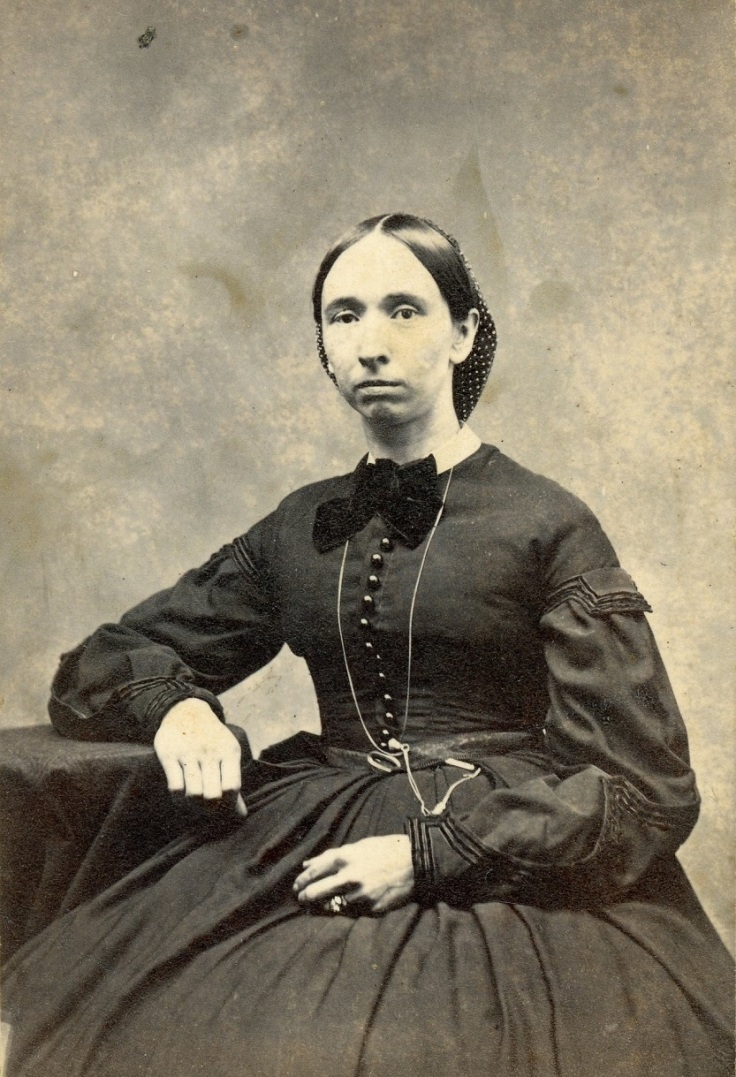

Both CDVs have a two-cent tax stamp on the back. Revenue stamps were required by the U.S. Government on commercial photographs from August 1, 1864 until August 1, 1866, initially to raise funds to fight the Civil War, and then to pay off debts after the war ended in May 1865. Photographers were required to cancel a stamp after affixing it to the back of a photo. On the stamps below, the letters H.C. are visible, for Henry Cushing, along with the abbreviation Feb. On the back of the first portrait (the woman’s), the year isn’t readable, but on the back of the man’s, I can just barely make out 186-. Only the top parts of the numbers are visible, but the last number looks different from the 6, so it must be a 5.



I hope you found this young couple appealing and intriguing as I did. I’d love to know more about them, but for the time being, their identities remain a mystery.

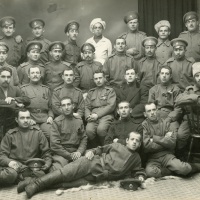
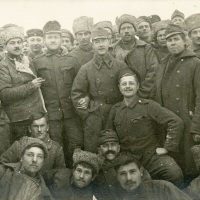
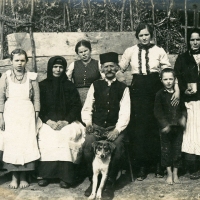
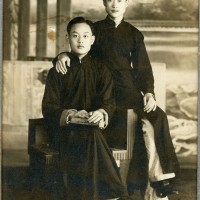
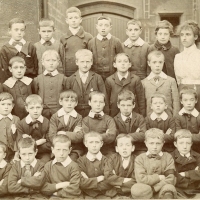

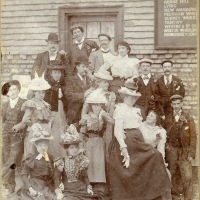
I think he’s quite handsome but the lady is rather plain. Still I think they could have been a couple. I’m not sure men always wore wedding rings in those days.
LikeLiked by 3 people
I agree. She has a most unfortunate receding chin. I don’t see a family resemblance between the two.
LikeLiked by 3 people
About the rings, that was my thought as well, that the absence of a ring didn’t necessarily define his marital status, whereas the presence of a ring would. He has a piercing gaze and maybe a hint of a smile. I thought he might be popular with the ladies. 😉
LikeLiked by 2 people
Young? I guess you’re right – they are young, although they don’t look it. At first glance I couldn’t see any resemblance between the two, but then I thought their lips were similar. She has empty eyes, as if she’s suffered a lot of disappointment in life.
LikeLiked by 2 people
I’d guess he’s around thirty, and she might be a few years younger. She does have sad eyes. I wondered if she might be in mourning, but would her dress have a white collar? In those days, people were often widowed and remarried by their thirties. Times have certainly changed in that regard.
LikeLiked by 2 people
Her dress does look very sober, but it made me wonder what kind of home she might have had. I’m reminded of ‘Little House on the Prairie’ and Laura’s friend Ida Brown, who was brought up in a very strict, what we would call fundamentalist Christian, ‘strictly-no-fripperies’ kind of household.
I also wonder what she is wearing round her neck, I can’t figure it out.
LikeLiked by 2 people
Interesting thoughts! I think it’s just a chain around her neck, and there seems to be a second chain at her waist, not attached to the first, but I could be wrong about that. There’s also a buckle (or ring) which isn’t attached to either. Or maybe it’s attached to the long chain? Hard to tell! There were many Quakers in New England, who emphasized modesty and humility in all aspects of life. Her hair is pulled back and almost hidden, which is very modest even for that time, so I wouldn’t be surprised if she came from a Quaker family.
LikeLiked by 2 people
Yes, indeed, the comments have been very interesting. I agree that they don’t seem to look like siblings. But they both have fascinating faces–very contemporary-looking, to me.
LikeLiked by 3 people
Very engaging discussion in the comments, Brad. I’m not sure she would be any type of fundamentalist Christian if we were to judge that from her clothing. Her snood is decorated, she has a large ribbon at their throat and there is ornate pin-tucking on her dress sleeves. I wish we knew more about the intriguing chain and attachments. I read the comments before looking carefully at her photo, and thought she might have been wearing a chatelaine, but it is too delicate for that. Her snood and the ribbon are both “black” and her dress a paler shade by comparison, so I doubt she’s in mourning. The snood and ribbon could be dark orange for all we know. I have a burnt orange dress that reads as black in the b & w photobooth I love to use, for example.
I cannot see any break in the small part of the gentleman’s collar that is visible at his chin. That made me think that he could perhaps be a chaplain or other servant of a church? I agree that there is a hint of a smile there.
Just because these two photos were purchased together and come from the same photographer doesn’t necessarily mean there is any relationship between the two images/people. In the 150 years since they were taken they could have been in the hands of numerous collectors, any one of whom could have filed them together solely on the basis of them coming from the same studio.
I loved your information about the tax stamps. It was all new to me. Very interesting!
LikeLiked by 3 people
Snood! I knew there was a word, but couldn’t remember it. Chatelaine is also a good word, which I had to look up after reading your comment. Now the challenge is to remember it! You may well be right about the fellow being a minister. That occurred to me also, especially since the photo was taken during wartime. Of course, he might already have served and returned home, or he might have received a waiver for some other reason.
About whether or not the photos might be connected to each other, my conclusion was based on the fact that they were both taken in February at the same studio. It would be a remarkable coincidence to find two photos taken so close together in time. However, your point is well made, and we always have to examine our assumptions regarding things sold together, and even regarding notes written on photographs. Notes and names are sometimes written much later by descendants, based on shaky information and assumptions.
Glad you found the tax stamps interesting! They always add a bit of unexpected color in an era of black and white and sepia.
LikeLiked by 3 people
I learned the word snood when I lived in London and was working with a Jewish woman who started wearing one once she was married. She always looked so glamorous in it. You are right, it is a great word!
Yes, the stamps add a lovely bit of colour and so much historical interest!
Re the two photos being taken in February and them being linked through that. It makes me wonder and hope that there is another cabinet card out there of them posing together. It isn’t beyond the realm of possibility that you find them. I’ve found photobooth photos of the same people at different ends of the USA, separated by years and years and been able to reunite them.
Can’t wait to see what comes up next on your blog Brad!
LikeLiked by 1 person
Ps. I loved the link to that superb bridge!
LikeLiked by 2 people
I live about 40 minutes from it, so I sort of take it for granted, but people come from far away to see it and drive through it. Thanks for looking! 🙂
LikeLiked by 2 people
How beautiful this couple
if somehow they are tied
I find him very charming
it would be nice to know their stories
🙂
LikeLiked by 2 people
I like them both very much. The more I look at a portrait, the more I feel I know the person, even if my rational mind tells me it isn’t true. Thanks for stopping by! 🙂
LikeLiked by 2 people
🙂
LikeLike
…..what interests me, as a VietNam draft resister, is why this young man escaped being clothed in a Union uniform. At that late period of the War of The Rebellion, virtually every man with two legs and two arms was being enlisted. You always bring us images worth pondering over!
LikeLiked by 1 person
Thank you, Lance. I had wondered about the man’s military status as well. This late in the war, he may already have served and returned home. Also, a man of means could pay another man to serve in his place, which sounds odd today but was fairly common, I think. It’s also possible he was a minister. Cheers from Vermont! Brad
LikeLiked by 1 person
….indeed–you bring up very good possibilities. Oh how we sometimes wish we could converse with some of them eh?
LikeLiked by 1 person